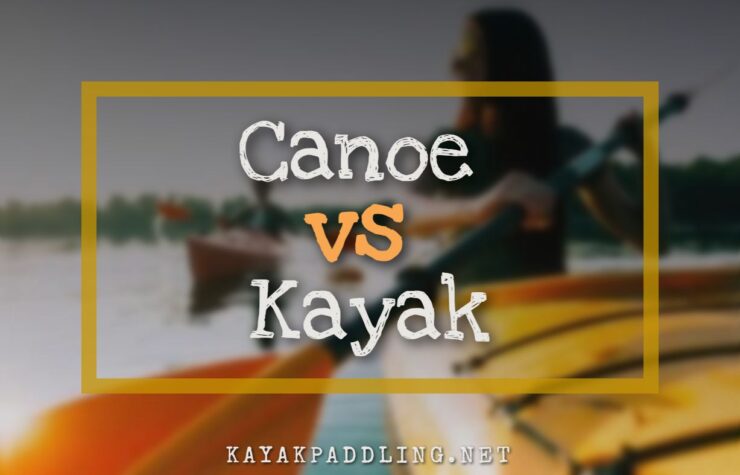Ever found yourself caught in a debate over canoes and kayaks? You’re not alone! These two terms are often used interchangeably, but they’re far from the same. Whether it’s the equipment, rowing position, or even their history, canoes and kayaks are distinct in many ways. Today, I’m going to take you on a journey through the world of canoe vs. kayak, highlighting the main differences between them.
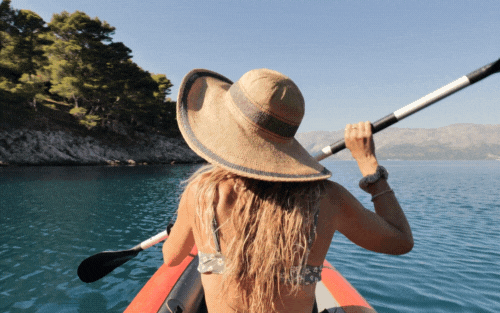
Let’s start with the basics: Canoes are usually open-top, and you’ll either kneel inside them or sit on small benches, propelling yourself with a single-bladed paddle. Kayaks, on the other hand, are closed-deck with a hole in the middle for you to climb and sit in, and you’ll use a double-bladed paddle to move. But trust me, there’s so much more to explore. So grab your paddle, and let’s dive right in!
Canoe vs. Kayak: Key Differences
You might think that all canoes and kayaks are the same, but there are some fundamental differences that set them apart. Let’s break it down:
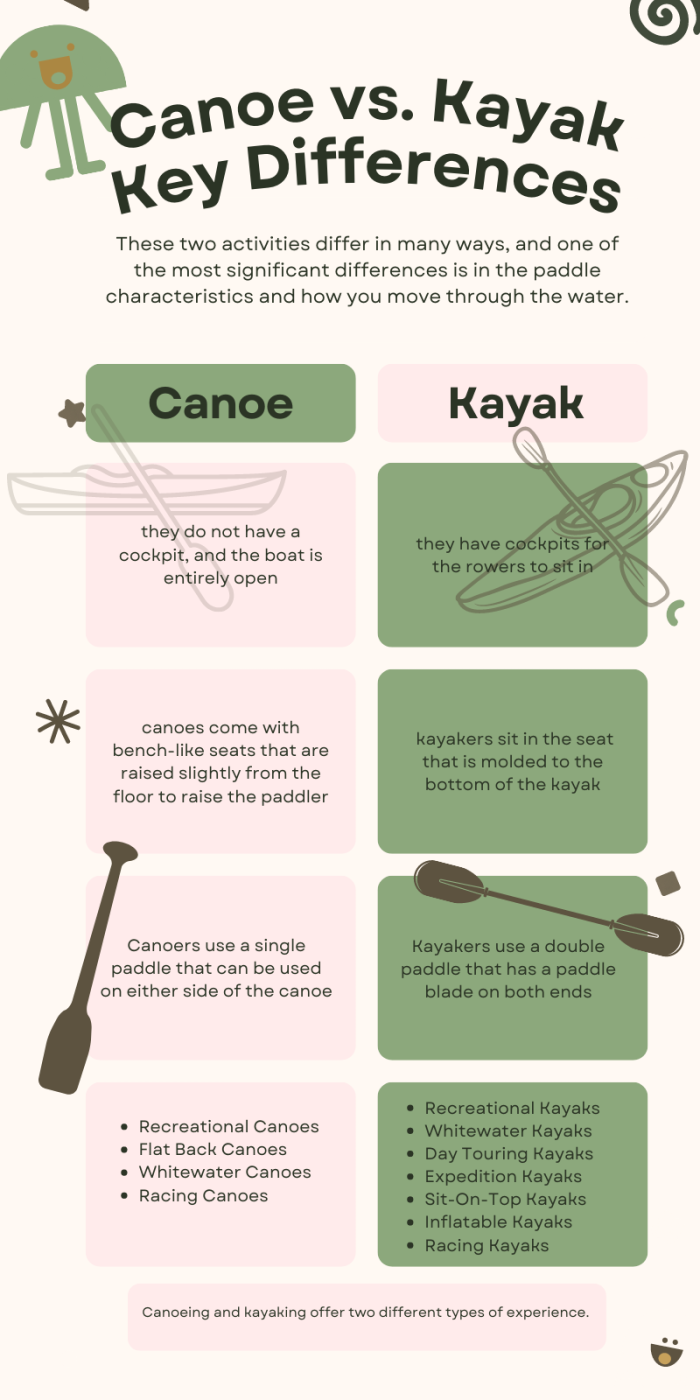
Cockpits
Canoes are like the convertibles of the boating world. They’re open, with sides rising high out of the water, and there’s no cockpit to speak of. It’s a design you’ll recognize from traditional rowing boats.
Kayaks, on the other hand, are the sports cars of the water. They’re closed, with specially designed cockpits for you to sit in. They ride lower in the water, and you’ll often see paddlers wearing spray skirts to keep the water out.
Seats
In a canoe, you’ll find bench-like seats slightly raised from the floor. Some canoes even have two or three seats! Though they’re comfortable, many canoers prefer to kneel for more power, especially in challenging conditions.
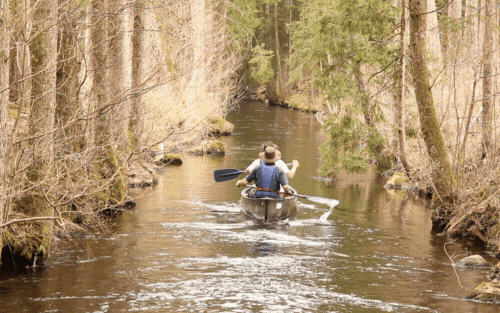
Kayaks offer a more tailored experience, with seats molded to the bottom of the boat. Your legs are in front, and you’ll use your knees to brace against the sides. It’s a technique that advanced paddlers use to maximize their paddling effectiveness.
Paddles
As a canoer, you’ll use a single paddle, and you might even learn the famous “J” stroke, allowing you to paddle in a straight line without swapping sides. It’s energy-saving and highly effective.
Kayakers, however, use a double paddle with blades on both ends. Paddling on alternate sides can feel like less effort, and it’s a rhythm that many find to be second nature.
Types of Canoe
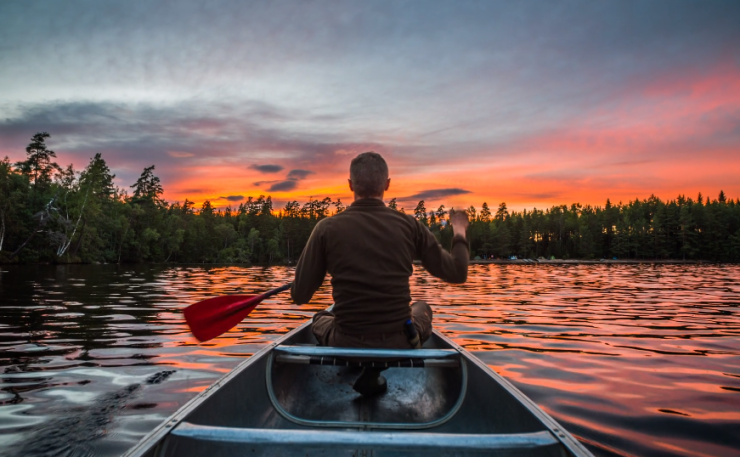
Let’s talk canoes! There are four main types, each crafted to suit different needs. Allow me to guide you through these varieties, painting a vivid picture of their unique features and uses.
1. Recreational Canoes
Imagine gliding across a calm lake or slow-moving river. That’s where recreational canoes shine. Ranging from 13 to 17 feet, they’re the most common type you’ll see, designed for stability and ease. Whether you’re paddling solo or with a couple of friends, these canoes feel right at home on tranquil waters.

2. Flat Back Canoes
Ever thought of adding a motor to your canoeing experience? Flat-back canoes have a flat rear just for that! Perfect for longer trips or fishing adventures, the gentle output from a trolling motor can give your arms a well-deserved break.
3. Whitewater Canoes
For the thrill-seekers, whitewater canoes are shorter and more maneuverable but trickier to steer straight. Outfitted with air-filled flotation panels, they’re built to tackle the wild rapids without sinking.
4. Racing Canoes
Speed demons, take note! Racing canoes are sleek, narrow, and low in the water. Designed for solo or duo racing, paddlers adopt a unique half-sitting, half-kneeling stance to maximize power and speed.
Types of Kayaks
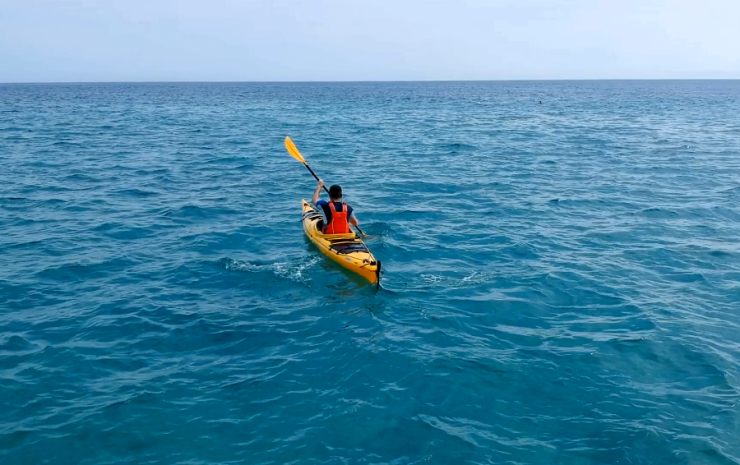
Now, onto kayaks! Some argue that kayaks are more versatile than canoes, and with the variety available, they might have a point. Let’s explore the different types and their specific purposes.
1. Recreational Kayaks
Ideal for calm waters like lakes and slow rivers, recreational kayaks are all about stability and comfort. Ranging from nine to twelve feet, they’re perfect for a relaxing paddle and are tough to tip over.
2. Whitewater Kayaks
Shorter and wider, whitewater kayaks are built for responsiveness on turbulent waters. Their dimensions vary, but their purpose is clear: to conquer the rapids!
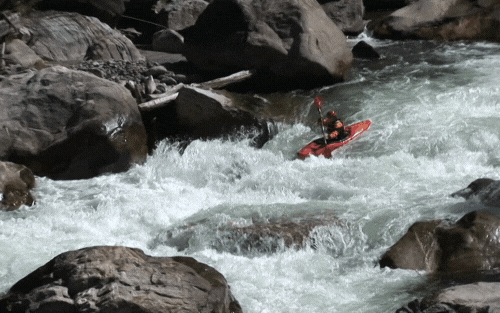
3. Day Touring Kayaks
Longer than their whitewater cousins, day-touring kayaks offer speed for longer distances. With storage holds and sometimes even skegs for steering, they’re perfect for a day’s adventure.
4. Expedition Kayaks
Planning a camping trip by kayak? Expedition kayaks have you covered. Longer and wider, they offer ample dry storage for all your camping needs.
5. Sit-On-Top Kayaks
For those warm-weather paddles, sit-on-top kayaks offer a molded top to sit on, making them great for flat, calm waters, fishing, or beginners.
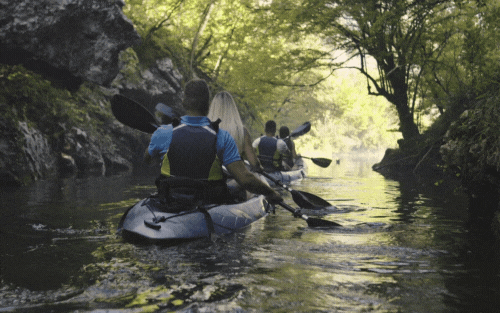
6. Inflatable Kayaks
Fun, comfortable, and portable, Inflatable kayaks are family-friendly and similar to canoes in design. Their downside? They’re less durable than other types.
7. Racing Kayaks
Last but not least, racing kayaks are all about speed. Long, slim, and light, they range from seventeen to thirty-six feet and sit low in the water, equipped with a rudder for precise direction.
Canoeing and Kayaking: Which One Is Better?
Ah, the age-old debate: canoeing or kayaking? Which one reigns supreme? Well, it’s not as simple as picking a winner. Both offer unique experiences, and the choice often boils down to personal preference. Let’s dive into the details and see if we can help you decide.
Canoes: Paddling and Turning
In a canoe, you’ll sit at the back, wielding a single-bladed paddle. You’ll alternate between sides to keep a straight line, and turning is as simple as paddling on one side or using the paddle like a rudder. But remember, that rudder trick only works if you’re already moving!
Kayaks: Paddling and Turning
Kayaking is a bit different. Seated in the middle, you’ll use a double-bladed paddle, and the balance of strokes keeps you straight. Turning is similar to canoes, either by stroking on one side or using the paddle as a rudder.
Canoe vs. Kayak: Comfort Level
Comfort is a big factor in choosing between these two. Canoes are wide open, making them easy to enter and exit, but their seats are more basic. Kayaks, on the other hand, often offer extra back support and protection from splashes. It’s all about what feels right for you.
Canoe vs. Kayak: Stability
Canoes are wider and more stable, thanks to their deep and wide hulls. They’re designed to carry more gear and people. Kayaks are more maneuverable but can be less stable, especially if you shift your weight while paddling.
Is Kayak or Canoe Better for Fishing?
Fishing enthusiasts, listen up! Both canoes and kayaks have their perks. Canoes are spacious and comfortable for long fishing sessions, and you can even add a motor. Kayaks are designed for rough waters and are great for solo fishing but might get uncomfortable on longer trips.
Which One Is Faster, the Canoe or Kayak?
Speed demons, or kayaks might be your choice. They’re generally faster, thanks to their sleek design. Canoes are heavier and require more energy to reach the same speeds.
Canoe vs. Kayak: Which One Is Better for Beginners?
New to the water? Kayaks are easier to start with, but advanced techniques might be trickier to master. Canoes have a steeper learning curve but can lead to easier mastery of advanced skills.
Tips for Beginners
For Kayakers:
- Dress for the water, not the weather.
- Start with a sit-on-top kayak.
- Always wear a life jacket.
- Sit properly to reduce flipping.
- Learn proper paddling techniques.
- Bring spare clothing.
- Paddle with an experienced friend.
For Canoers:
- Paddle with a partner on opposite sides.
- Synchronize your paddling rhythm.
- Always wear a life jacket.
- Dress for the water, not the weather.
- Practice getting in and out of the canoe.
- Avoid unnecessary risks.
- Bring extra clothes.
Canoe vs. Kayak: Which One Is More Family-Friendly?
Planning a family outing? Canoes might have the edge due to their size and storage capacity. They can hold all the essentials, from life jackets to snacks.
Canoe vs. Kayak: Price
When it comes to cost, canoes are generally pricier, ranging from 500 to 1000 USD, while kayaks fall between 350 and 850 USD. Of course, prices can soar into the thousands, depending on the brand and type.
Which One Performs Better in Different Water and Weather Conditions?
When it comes to braving the elements, kayaks, and canoes each have their own strengths and weaknesses.
Kayaks: These sleek vessels are built for the open sea, choppy lakes, fast rivers, and wild whitewater. Thanks to their exceptional secondary stability, they resist rolling and tipping in rough waters. Cold and windy weather? No problem! Kayaks are perfect for those early spring or late fall paddles.
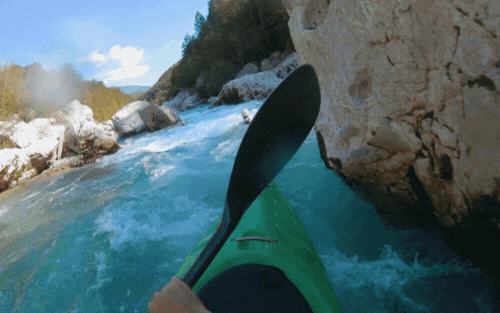
Canoes: If calm and placid waters are more your style, canoes are the way to go. They shine on gentle lakes and slow rivers. But beware, a sudden gust of wind or rough waters can make them prone to capsizing. On hot, windless days, you’ll stay dry and enjoy the ride.
Canoes and Kayaks: Main Benefits and Drawbacks
Now that we have brought out all the important features of both kayaks and canoes, it is time to summarize and weigh all advantages and disadvantages each variety brings. It will paint you a better picture of which boat is better suited for your purposes.
- Width and stability
- Easy to enter and exit
- High load capacity so that you can carry more supplies
- Ideal for longer travels and expeditions
- Difficult to capsize
- You can switch sitting positions and make your journey more comfortable
- You are able to stand up in it
- After you learn the basics, mastering canoeing is easier than it is the case with kayaks
- You will remain dry for longer unless you are paddling on whitewater
- It is suitable for kids and animals as well
- The seating position is high, so you are able to get a better view of the surroundings
- Easier bypassing sections of water via land
- Bulky, heavy, and difficult to store and move from place to place
- It may be difficult to learn basic paddling skills, especially if you are paddling solo
- Single-bladed paddles are not as efficient as double-bladed ones, and they consume more energy from the paddler
- Difficult to paddle at top speed
- Less maneuverable than kayaks and require more effort when turning
- It is pretty easy to pick up the basics, making it much more accommodating for beginners
- Kayaks go faster and require less effort from the paddler than is the case with canoes
- More options in kayaking disciplines than there are in canoeing
- Your equipment and supplies will stay drier in a kayak than in a canoe
- Very light and easy to move from place to place
- Easy to maneuver
- Kayaks are much better in whitewater than canoes
- Double-bladed paddles are very efficient, and they consume less energy to paddle with
- Sit-inside variations have dry storage holds
- Sit-inside variations have closed cockpits, protecting you from the sun, wind, and spray
- It is difficult to avoid getting wet during a kayaking session
- It takes longer to master advanced kayaking techniques
- Double-bladed paddles are heavier than single-bladed ones
- Kayaks are less stable than canoes and are more prone to capsize
- Lower load capacity than canoes
- Difficult to enter and exit from
The Cultural Significance of Canoes and Kayaks
Both kayaks and canoes come with their set of pros and cons. The bottom line is that the purpose for which you are buying the boat matters the most. For example, if you need it for some more family-friendly trips, then a canoe is the way to go, while if you need the vessel for racing and more dynamic adventures, a kayak will provide everything you need.
The Cultural Significance of Canoes and Kayaks One aspect that’s often overlooked is the historical and cultural roots of these vessels. Kayaks were originally designed by indigenous peoples of the Arctic for hunting and fishing, built to be stealthy and easy to maneuver. Canoes, on the other hand, have a broader cultural background, utilized by various native tribes across North America for transport and trade. Understanding the origins can lend a deeper appreciation for the designs and functions of each.
Skill Levels and Learning Curves
Both canoeing and kayaking offer opportunities for skill development. For instance, kayaking involves learning techniques like the Eskimo roll, a maneuver to right oneself after capsizing. Canoeing, too, has its own set of advanced skills like the draw and pry strokes for quick, sharp turns. Beginners might find paddling clinics or guided tours useful for acquiring these skills.
Fitness Benefits
Both activities offer robust workouts. Kayaking provides an excellent upper body exercise, engaging your core and shoulders. Canoeing, depending on the technique, can be a full-body workout, especially when kneeling and employing your legs for additional force. They are both excellent for cardiovascular health.
Environmental Considerations
Both canoes and kayaks allow you to explore natural settings with minimal environmental impact. However, some areas may have restrictions to protect local ecosystems, so always check local guidelines. Additionally, paddlers should adhere to Leave No Trace principles to minimize their impact.
Safety Gear and Accessories
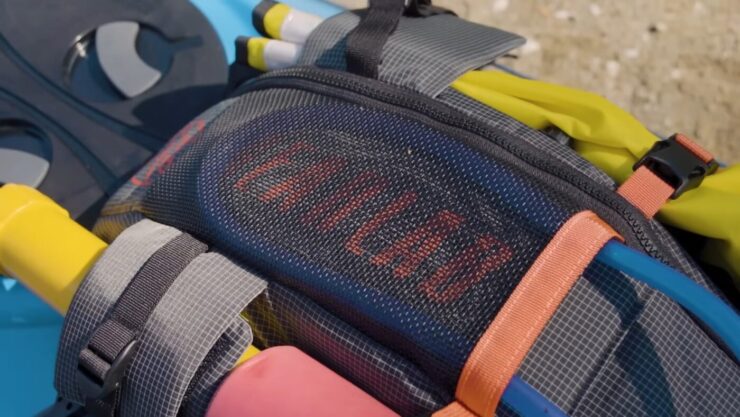
Besides life jackets, there’s other safety gear you might consider. Helmets are often recommended for whitewater conditions. Likewise, dry bags are useful for keeping valuables safe and dry. For kayak fishing, specialized holders for fishing rods and tackle boxes can be added.
Solo vs. Group Adventures
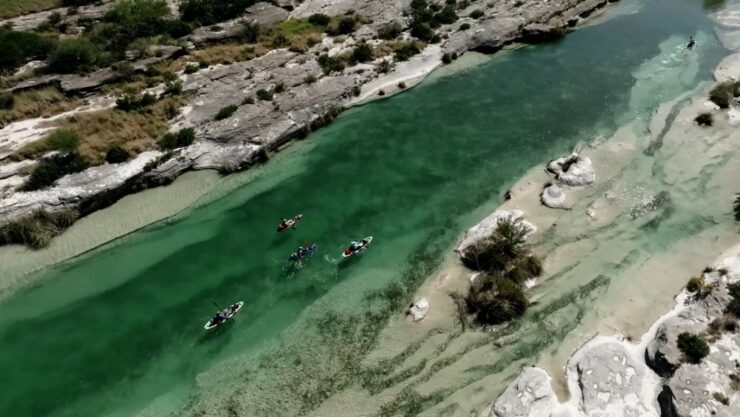
While both canoes and kayaks can be operated solo, canoes are generally better suited for group trips, both for social experiences and for dividing up the effort of paddling and portaging. Kayaks are more focused on individual performance, making them great for solo adventures where you want to set your own pace.
Adaptive Options
For individuals with disabilities, there are adaptive canoes and kayaks equipped with special seating, stabilizers, and paddle adaptations, making water sports more accessible to everyone.
FAQ
Can I use a kayak for fishing?
Absolutely! Fishing kayaks are designed to be stable and often come with features to enhance your fishing experience.
Can I stand up in a kayak like I can in a canoe?
Generally, standing up in a kayak is not advisable due to its lower stability compared to canoes. Some specialized fishing kayaks are designed with wider hulls to allow standing, but traditional kayaks are usually not stable enough for this.
In contrast, the broader and more stable design of a canoe often allows for standing, which is especially useful for fishing or stretching during long journeys.
Is canoeing suitable for children?
Yes, canoes are often more family-friendly due to their size and stability. Just make sure to have proper safety equipment for the little ones!
How do canoes and kayaks differ in terms of steering and control?
Canoes often rely on strokes like the “J” stroke or the use of a paddle as a rudder to help steer and maintain a straight line. Kayaks typically have a higher degree of maneuverability due to their shape and use of a double-bladed paddle, which allows for quicker, more efficient turns.
Some kayaks even come equipped with a foot-operated rudder system for additional control.
Can I take a canoe into the ocean?
While canoes are typically better suited for calm waters, experienced paddlers may take them into coastal areas. Be mindful of weather conditions and tides.
Is one easier to transport than the other?
Kayaks are generally easier to transport than canoes. They are often lighter and equipped with handles at both ends, making them easier for one person to carry. Canoes are usually bulkier and may require two people to move them safely. Additionally, kayaks are more streamlined, making them easier to strap onto the roof of a car.
How do I store my kayak or canoe?
Both can be stored indoors or outdoors with proper covers. Make sure to clean and dry them before storing to prevent damage.
Can I bring my dog along in a kayak or canoe?
While it is possible to bring a dog in both a canoe and a kayak, a canoe is usually a better option for this. The open deck and wider space in a canoe make it more comfortable and safer for a pet.
Kayaks have limited space, and not all dogs will be comfortable or safe in such a confined area, especially if the kayak is a sit-inside type.
What’s the learning curve like for kayaking vs. canoeing?
Kayaking is generally easier to pick up for beginners, while canoeing might take a bit more practice. Both offer unique challenges as you advance.
What are the best conditions for canoeing and kayaking?
Canoes are generally better suited for calm, flat waters like lakes and slow-moving rivers. They are also better for trips that require carrying more gear. Kayaks are versatile and can be used in a variety of water conditions, including flat water, rapids, and open sea. The best conditions depend on the type of kayak or canoe you are using and your level of expertise.
Can I add a motor to my canoe or kayak?
Some canoes are designed to accommodate motors, and there are even specialized motorized kayaks. Check the specifications of your vessel to be sure.
How do I choose the right size for a canoe or kayak?
The size of the canoe or kayak you should choose depends on several factors including your skill level, the type of water you will be navigating, and whether you’ll be paddling solo or with others. As a general rule, longer boats are faster but less maneuverable, while shorter boats are more maneuverable but slower.
For canoes, sizes can range from about 13 to over 18 feet, while kayaks can range from about 9 to over 15 feet for non-racing types. Always consult with experts and possibly rent different sizes before making a decision.
Final Words
Choosing between a kayak and a canoe is like choosing between two different adventures. Crave the thrill of rough waters? Go for a kayak. Looking for stable, family-friendly fun? A canoe might be your best bet.
It’s a big decision, so take your time. Consider what you want from your aquatic experience, and don’t be afraid to revisit the details. Your perfect vessel is out there waiting!
Hey there! I’m Oliver Adler, the kayak-paddling, fish-catching enthusiast. My love for the water started with a childhood spent by the sea, and it’s grown into a lifelong passion for everything from kayaking to kite surfing, and yes, even fishing.
Related Posts:
- 16 Best Kayak For Beginners 2024 - Kayaking Adventure Gear
- Heavy Duty Fishing: 11 Best Rods And Reels For Big Fish 2024
- 12 Best Beach Wagons & Carts 2024 - For All-Terrain
- 12 Best Motorized Kayak 2024 - Start Your Aquatic Adventure!
- 10 Best Fishing Canoes 2024 - All-Around and Trolling
- 10 Best Fish Finders Under $200 2024 - Top Affordable Picks

